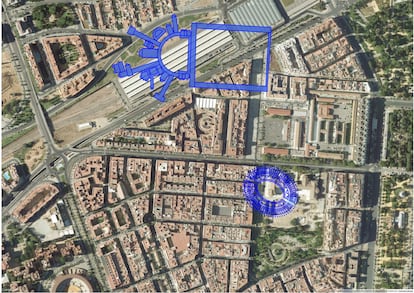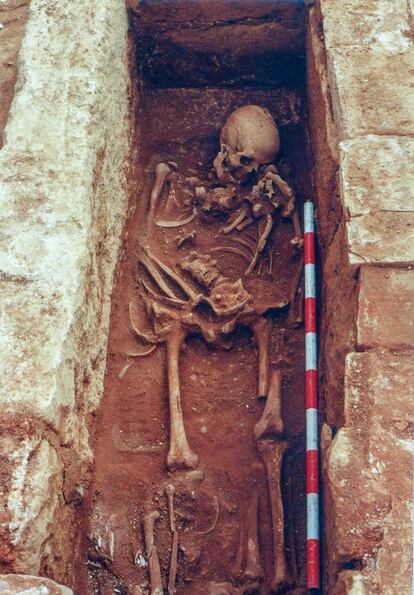In Spain, loss of Roman Empire’s largest palace to make way for a high-speed-train station still hurts
It is now 30 years since authorities prioritized Seville Expo infrastructure over national heritage and backed the destruction of a vast complex built by Emperor Maximian Herculius in Córdoba

It was a massive, brutal attack on Spain’s historical heritage; an unmitigated plundering of a national asset that left “an open wound,” according to Camino Fuertes, an archaeologist from the Andalusian Agency of Cultural Institutions. Fuertes on Tuesday delivered a talk, Thirty years after Cercadilla, to mark the destruction of the Roman imperial palace of Córdoba, built by Emperor Maximian Herculius between the years 293 and 305.
“It’s tremendously painful,” adds Ana Zamorano, president of the cultural association Friends of Medina Azahara, which organized online events to observe the date, such as Cercadilla, The Loss of Innocence. The complex, which sprawled over eight hectares, was razed in May 1991 to make way for a high-speed AVE train station in Córdoba, in the southern region of Andalusia. Spain’s inaugural AVE line was being built from Madrid to Seville to coincide with the fact that the latter city would host the 1992 World Expo.
A minor railway station had already been occupying part of the site since the 19th century. The stop included a small building, a platform, a parking lot and a railway junction that allowed for a change of direction. Then, on May 22, 1991, following the decision to replace the old station with a new one that would accommodate the AVE, the excavators came in to dig up the earth and destroy the ancient palace and its surroundings. Archaeologists worked flat out to try to save what they could. But within the space of a few days, an area spanning half a kilometer long by 200 meters across had been destroyed. There were media reports about the destruction of tombstones, mosaics, a Roman theater, a temple, a circus, an amphitheater and a palace.
The archaeologists excavating the site slept next to the remains to try to prevent their demolition and posted ads to save a site “larger than Trajan’s Forum in Rome,” according to Rafael Hidalgo, co-director of the dig. But the local, regional and national authorities’ decision was final, and there was no room for appeal: the AVE high-speed train from Madrid to Seville, where the Universal Exposition was to be inaugurated in 1992, had to stop in Córdoba in that exact spot, no matter what.
“It was nothing short of plundering,” says Fuertes who participated in a talk organized by the Municipal Institute of Tourism of Córdoba. “A fake news campaign was orchestrated against the site. It was said that if the site was not razed, the AVE would never reach Córdoba; that what was found was worthless; that archaeologists were getting rich on the excavations; that the remains were going to be incorporated into the station and, finally, that all the railroad tracks would be rerouted. It was all absolutely untrue.”
The mayor of Córdoba at the time, Herminio Trigo of the United Left (IU), called the site “a bunch of rocks.” The magazine Época published a story in March 1992 that said neither the central nor regional governments, both run by the Socialist Party (PSOE), did anything to save the site. Rather, they looked the other way and even defended the destruction. In September 1992, an international commission of experts stated that they could be looking at a unique world monument that should be respected and studied. “It was the largest one in the entire Roman Empire,” said Hidalgo along with the other co-director of the dig at the time, Pedro Marfil.
Meanwhile, the Jesuit archaeologist Manuel Sotomayor, winner of the Andalusian government’s Historical Heritage Award, described Cercadilla as “an impressive excavation.” And Miguel Rodríguez-Pantoja, a professor at the University of Córdoba, said it was “unique due to its size, the period in which it was built and its enormous significance. It is hard to believe that it will be destroyed.” Juan Ojeda, a lawmaker for the conservative Popular Party (PP), denounced the authorities’ policy of “fait accompli” and said that “Córdoba has to know the truth. What is about to be destroyed is unique in the world.”

A huge seat of imperial power was built at the end of the 3rd century AD at a location 600 meters northwest of the walls of the settlement of Patricia Corduba. This was to be the political center of the Diocese of Hispania, and it was the point from which Maximian ruled the entire peninsula and North Africa. The palace complex was divided into two main areas. The first was a huge rectangular square with military features connected to the palace area. To access the latter, it was necessary to go through a gate with large towers on either side. The palace area was linked by a cryptoportico – a semi-circular covered gallery with columns – 109 meters long that provided access to the complex’s various public and private buildings.
According to Hidalgo, “the great exedra [the semicircular portico with columns] constituted a large open square, free of buildings, which acted as a reception area for those who enjoyed the privilege of accessing the interior of the palace, allowing the distribution of transit to the different reception spaces surrounding it through its portico.”

After passing through the cryptoportico, visitors could choose between three different transit circuits: the public one, composed of official buildings; the semi-public one, with two areas for banquets, or the private one, consisting of smaller rooms, such as the baths. Fuertes points out that the throne room where the emperor held receptions was located at the center of the official buildings.
In the 6th century, as the Roman period came to an end, three of the complex’s buildings were converted for Christian worship, possibly in honor of the Córdoba martyr and patron saint of the city, Saint Acisclus. The temple had a large cemetery around it containing hundreds of tombs. During the Caliphate period starting in the 8th century, Christians continued to occupy its buildings until 1010, when a civil war forced them to leave.

In 1991, the archaeologists asked for the site to be declared an Asset of Cultural Interest (BIC), the highest possible heritage protection. They even took out an ad consisting of a list of signatories calling for the urgent protection of the site. But the regional government of Andalusia did not respond. In 1995, when more than half the site had been bulldozed, the Ministry of Culture opened a protection file. In 1997 it was declared a BIC. “It was one of the few imperial palaces that existed in the world,” says Fuertes. “We can no longer do anything about it. It is a wound in the heart of Córdoba that we have not yet known how to heal.”
In 2006, the archeological remains that were saved from destruction and which lay on the other side of the station’s exterior wall – baths, more than 80 meters of the cryptoportico, the imperial apartments, the triple apse rooms at the end of the palace area and an aqueduct – were opened to the public.

In 2015, the Andalusian regional authorities unilaterally transferred the management of the archaeological park to the city of Córdoba, which keeps it closed. Since then there have been no maintenance policies implemented or conservation actions taken. “Imagine that the palace had been completely preserved,” says Fuertes. “Imagine that Córdoba received visitors getting off the AVE with the remains of the largest Roman imperial palace known to exist…”
In an article published in February 1992 in the daily Diario de Córdoba, Professor Rodríguez-Pantoja wrote: “It won’t be long before we will seem to our own children as barbaric as those who made so much greatness disappear [in Córdoba] with fewer means and knowledge.” It will now be 30 years since those prophetic words were uttered.
English version by Heather Galloway.
Tu suscripción se está usando en otro dispositivo
¿Quieres añadir otro usuario a tu suscripción?
Si continúas leyendo en este dispositivo, no se podrá leer en el otro.
FlechaTu suscripción se está usando en otro dispositivo y solo puedes acceder a EL PAÍS desde un dispositivo a la vez.
Si quieres compartir tu cuenta, cambia tu suscripción a la modalidad Premium, así podrás añadir otro usuario. Cada uno accederá con su propia cuenta de email, lo que os permitirá personalizar vuestra experiencia en EL PAÍS.
¿Tienes una suscripción de empresa? Accede aquí para contratar más cuentas.
En el caso de no saber quién está usando tu cuenta, te recomendamos cambiar tu contraseña aquí.
Si decides continuar compartiendo tu cuenta, este mensaje se mostrará en tu dispositivo y en el de la otra persona que está usando tu cuenta de forma indefinida, afectando a tu experiencia de lectura. Puedes consultar aquí los términos y condiciones de la suscripción digital.
More information
Últimas noticias
Most viewed
- Sinaloa Cartel war is taking its toll on Los Chapitos
- Oona Chaplin: ‘I told James Cameron that I was living in a treehouse and starting a permaculture project with a friend’
- Reinhard Genzel, Nobel laureate in physics: ‘One-minute videos will never give you the truth’
- Why the price of coffee has skyrocketed: from Brazilian plantations to specialty coffee houses
- Silver prices are going crazy: This is what’s fueling the rally









































